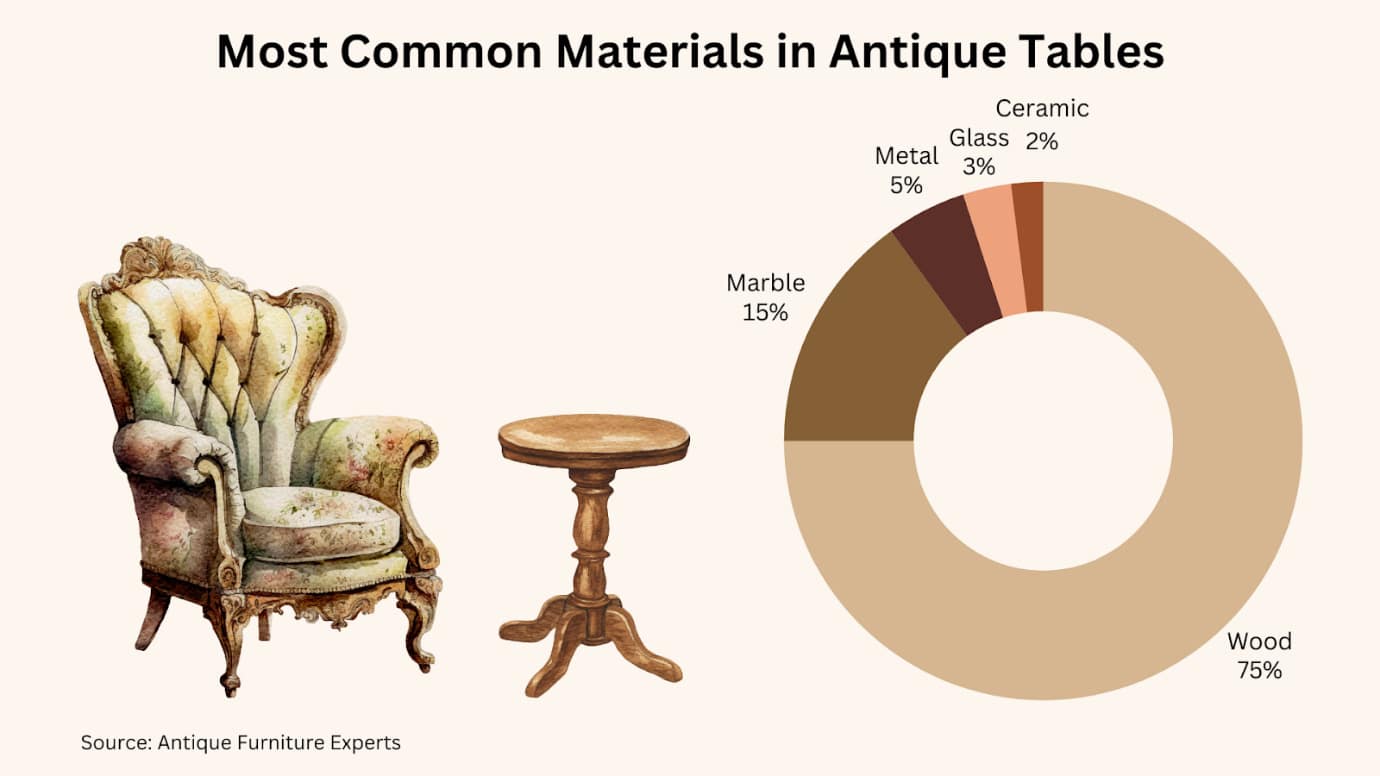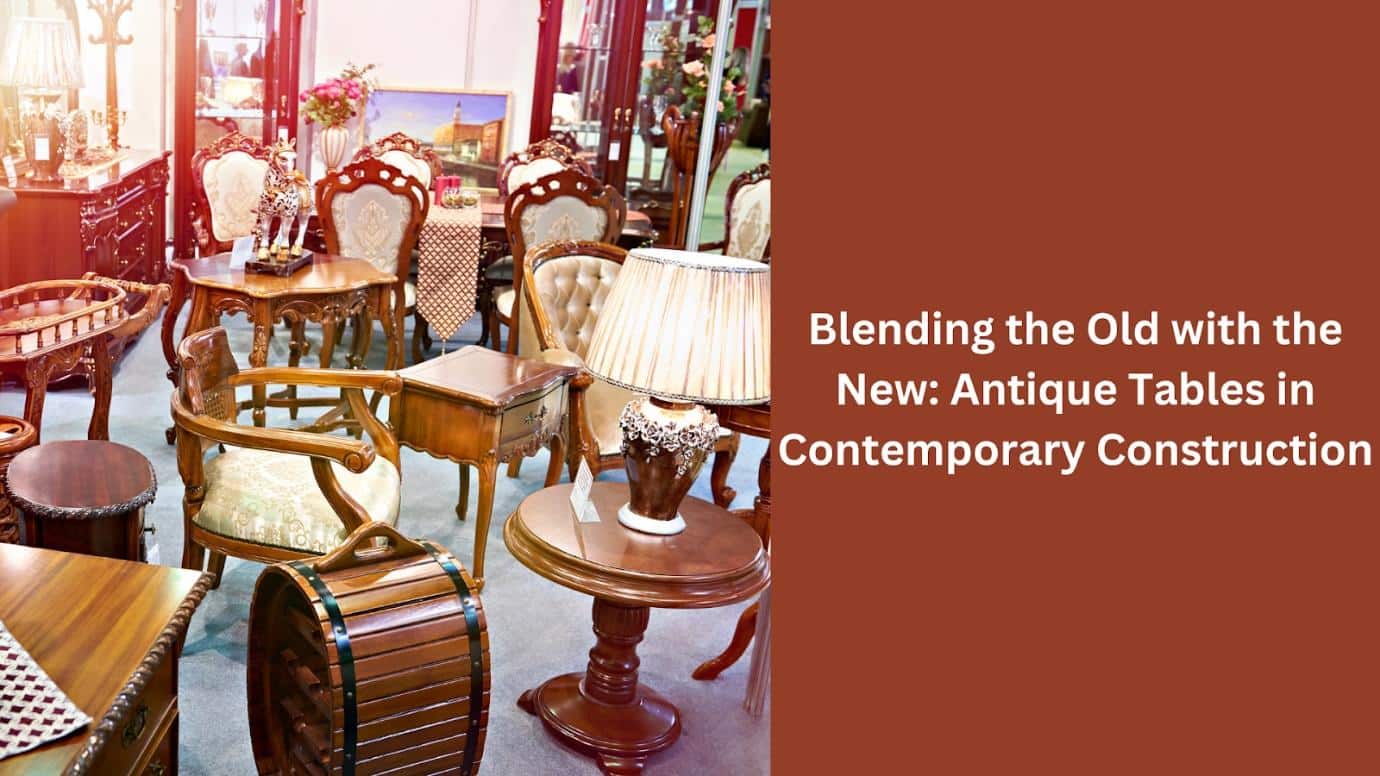Interior design trends are constantly evolving, but one classic method never seems to vanish. This involves combining vintage items with modern spaces. This holds especially true when discussing the use of antique tables in contemporary construction and interior decorating. Antique tables evoke a sense of history, expert craftsmanship, and unique character. They perfectly balance a simple and clean design.
Table of Contents
The Lasting Charm of Vintage Tables: Old is Gold.
Old furniture has a special appeal that always seems to make an impression. The global antique furniture market is projected to grow by 6.8% annually from 2021 through at least 2028 due to increasing worldwide demand.
The History Behind Antique Appeal
A lot of old furniture’s charm comes from its deep history. These items have truly stood the test of time. Some old tables go back thousands of years to ancient times in places like Egypt, Greece, and Rome. Those are spots where making furniture started. Antique wood surfaces, markings, and imperfections give hints into the following:
- The table’s legacy
- The craftsmen
- Previous owners
- Events they’ve seen over decades or centuries
Each antique table has a unique story to tell that creates an emotional connection.
The One-of-a-Kind Factor
Beyond their histories, antique tables bring a special character to spaces. They are handcrafted by artisans using manual woodworking and finishing methods. Each item carries the maker’s subtle signatures and quirks. Everything gives antique tables a patina and personality. It can be found in the varying grain patterns, knots, and nail holes to the different carving, aging, and distressing. Factory-produced furnishings cannot replicate those on such a bespoke level. These distinctive features contribute to the authenticity of antique tables.
The Element of Imperfection
Machine-made modern furnishings focus on consistency in materials and finishing. The variations found in antique tables are what add to their beauty. The natural flaws that come with weathering over decades echo the cycles of time and use. Examples of these include splits in grain, watermarks, and peeling varnish. They make an emotional human connection. Rather than concealing their blemishes, experienced antique collectors highlight these imperfections. They use a thoughtful restoration to showcase the authenticity and history within each piece.
Contemporary Design Increasingly Embraces Antique Accents

The worldwide modern interior design market has recently exceeded $130 billion in value. Contemporary aesthetics continue gaining popularity across the world. Current trends embrace minimalism, open layouts, neutrals, and functionality above all else. But expert designers realize even the most modern, stripped-down rooms still need a special something. It will give them warmth and character and counterbalance the hard surfaces. This is where thoughtfully placed antique furniture comes into play.
Purposeful Imperfection
Antique tables inject a deliberate sense of aged contrast into these minimalist environments. It is where everything is polished, matte, and uniformly textured. The imperfect surfaces of antique wood provide depth and visual interest compared to modern finishes, which can sometimes seem too sterile. Strategically placed antique dining tables, consoles, or sideboards are the perfect focal points. Imagine placing them against today’s popular neutral backdrops of white, beige, and black.
Adding Warmth
Beyond visual appeal, antique tables bring a welcome sense of warmth into contemporary rooms in more ways than one. The aged patinas and wood grain textures are inviting to the touch, grounding these sleek spaces. Antique tables also carry the very essence of history. They conjure images of large families gathering around them for generations. They mark milestones and create memories. These nostalgic elements bring back human connection into the removed sensation of minimalism.
Choosing an Antique Table in Harmony with Contemporary Spaces
When sourcing an antique table for a modern home, careful selection is key to creating a cohesive finished look. The first consideration is size and proportion. An antique table needs to suit both the room it occupies and the scale of surrounding modern furnishings. An oversized antique piece will overpower the space, just as a petite antique will get drowned out.
The next factor is material and craftsmanship. High-quality woods such as mahogany and walnut do more than provide exquisite grain patterns. They also stand up well next to modern finishes like marble, steel, and stone. Hand-carved details or ornate metal inlays echo subtle sleek accents within contemporary decor.
Finally, the style of the antique table must align with the room’s aesthetic. It can be a mid-century modern, contemporary rustic, urban industrial, or modern farmhouse. A Rococo antique side table would clash amidst a contemporary living room. Meanwhile, an 18th-century French farm table would complement a modern kitchen beautifully.
Incorporating Antique Tables into Contemporary Interiors
Once you’ve sourced the perfect antique piece, it becomes a matter of seamlessly incorporating it into the modern space. Strategic placement is critical. Imagine an antique dining table anchored at the end of a hallway or a repurposed antique console floating midway in an open-concept great room. Surrounding décor choices also must strike an effortless balance. Think of pairing a distressed antique coffee table with sleek sectionals and a contemporary area rug.
When done thoughtfully, the antique table serves as a subtle yet striking focal point. It is also a good conversation starter amidst the home’s contemporary framework. It awakens visual interest and brings an infusion of heritage. These well-crafted antique pieces impart the welcoming comforts of the past. At the same time, they fit into the present. They resemble family heirlooms that have been cherished across generations.
Caring for Antique Tables Through the Years
The journey doesn’t conclude when that perfect antique piece finds its way home. Maintaining its beauty and durability amidst daily wear and tear necessitates proper care. Using good practice helps make sure old tables stay pretty and worth the money.
- Using correct cleaners, often dusting and polishing helps keep antique wood surfaces shining. At the same time, it removes rough bits little by little.
- Special waxes and oils can also care for old wood and stop it from drying out or cracking.
- Table mats and pads should stop spills, scrapes and damages to surfaces while being used.
- For major fixes, professional restoration businesses can mend damage to structures. They can also fix up surfaces while keeping old items just as they are.
With proper care and attention, your favorite old table can become a cherished family heirloom for generations.
Bringing It All Together
Incorporate vintage elements into contemporary spaces. It makes interesting comparisons and adds warmth while showcasing its history too. Simple and combined styles keep going strong in today’s interior design. This mixed method will become more famous. Discover the perfect antique piece and breathe new life into it within modern aesthetics. It bestows homeowners with a distinctive style, personality, and environmentally conscious choices. Modern furniture cannot replicate this charm.
Enhance your room with a touch of the past by acquiring an antique item. Next time you want to make a modern room look better with more design, we suggest this. The new possibilities that this approach offers are as unique and diverse as the antique tables themselves.
Frequently Asked Questions
Can antique tables be customized to fit modern interiors?
Yes, antique tables can adapt to work within modern rooms. Some customization options include adding new finishes, repurposing the piece into a fresh functional use, tailoring proportions, or combining it with modern decorative elements.
What precautions should I take to prevent damage to antique tables?
Use coasters, placemats, and table pads whenever possible. Dust and polish regularly using appropriate cleaners and conditioners. Avoid placing antique tables in direct sunlight or excessively high-traffic areas. Immediately clean spills to prevent lasting water marks or stains.
Are there any specific guidelines for incorporating antique tables into commercial spaces?
Yes. Consider scale/ proportions carefully to suit commercial square footage. Prioritize durable, high-quality antique woods like mahogany that can withstand heavy use. For dining tables, use heat proof pads to shield wood from hot plates. Position antique tables in easily accessible areas so staff can frequently wipe down surfaces.
We hope you’ve enjoyed learning more about seamlessly integrating antique tables into contemporary construction and design! What key takeaway resonated most with you? I welcome hearing your insights in the comments.





